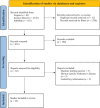Functional magnetic resonance imaging, deep learning, and Alzheimer's disease: A systematic review
- PMID: 36257926
- PMCID: PMC10092597
- DOI: 10.1111/jon.13063
Functional magnetic resonance imaging, deep learning, and Alzheimer's disease: A systematic review
Abstract
Alzheimer's disease (AD) is currently diagnosed using a mixture of psychological tests and clinical observations. However, these diagnoses are not perfect, and additional diagnostic tools (e.g., MRI) can help improve our understanding of AD as well as our ability to detect the disease. Accordingly, a large amount of research has been invested into innovative diagnostic methods for AD. Functional MRI (fMRI) is a form of neuroimaging technology that has been used to diagnose AD; however, fMRI is incredibly noisy, complex, and thus lacks clinical use. Nonetheless, recent innovations in deep learning technology could enable the simplified and streamlined analysis of fMRI. Deep learning is a form of artificial intelligence that uses computer algorithms based on human neural networks to solve complex problems. For example, in fMRI research, deep learning models can automatically denoise images and classify AD by detecting patterns in participants' brain scans. In this systematic review, we investigate how fMRI (specifically resting-state fMRI) and deep learning methods are used to diagnose AD. In turn, we outline the common deep neural network, preprocessing, and classification methods used in the literature. We also discuss the accuracy, strengths, limitations, and future direction of fMRI deep learning methods. In turn, we aim to summarize the current field for new researchers, suggest specific areas for future research, and highlight the potential of fMRI to aid AD diagnoses.
Keywords: Alzheimer's disease (AD); computer-assisted diagnosis (CAD); deep learning; deep neural networks (DNN); functional connectivity; functional magnetic resonance imaging (fMRI).
© 2022 The Authors. Journal of Neuroimaging published by Wiley Periodicals LLC on behalf of American Society of Neuroimaging.
Figures
References
-
- Gupta GL, Samant NP. Current druggable targets for therapeutic control of Alzheimer's disease. Contemp Clin Trials 2021;109:106549. - PubMed
-
- Australian Institute of Health and Welfare . Deaths in Australia: leading causes of death. Available from: https://www.aihw.gov.au/reports/life‐expectancy‐death/deaths‐in‐australi.... Accessed 5 Oct 2021.
-
- Liang C‐S, Li D‐J, Yang F‐C, et al. Mortality rates in Alzheimer's disease and non‐Alzheimer's dementias: a systematic review and meta‐analysis. Lancet Healthy Longev 2021;2:e479‐88. - PubMed
-
- Connolly S, Gillespie P, O'Shea E, et al. Estimating the economic and social costs of dementia in Ireland. Dementia 2014;13:5‐22. - PubMed
-
- Brown L, Hansnata E, La HA. Economic cost of dementia in Australia 2016–2056: report prepared for Alzheimer's Australia. Available from: https://www.dementia.org.au/sites/default/files/NATIONAL/documents/The‐e.... Accessed 5 Oct 2021.
Publication types
MeSH terms
LinkOut - more resources
Full Text Sources
Medical
Miscellaneous


